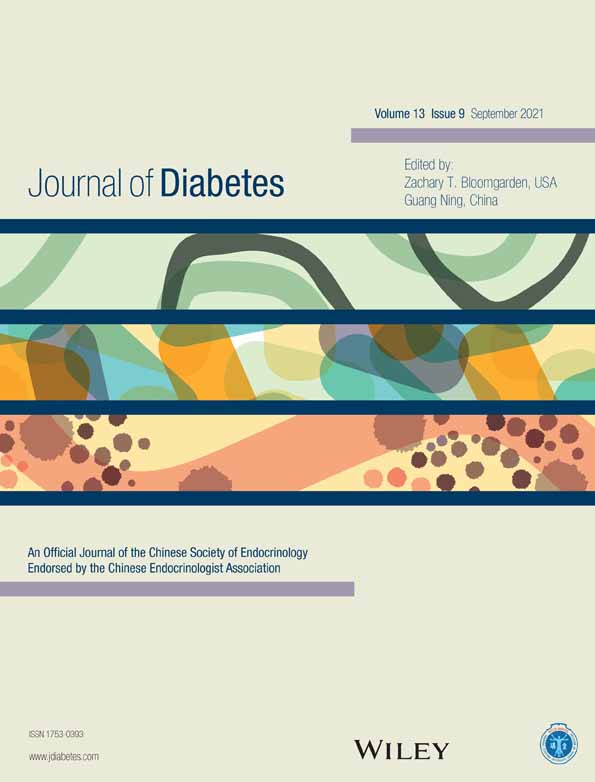Association of metabolic score for insulin resistance and its 6-year change with incident type 2 diabetes mellitus
胰岛素抵抗代谢评分及其6年变化与2型糖尿病发病的关系
Ming Zhang and Dechen Liu contributed equally to this work.
Funding information: National Natural Science Foundation of China, Grant/Award Numbers: 81402752, 81673260; Natural Science Foundation of Guangdong Province, Grant/Award Number: 2019A1515011183; Science and Technology Development Foundation of Shenzhen, Grant/Award Numbers: JCYJ20170412110537191, JCYJ20190808145805515
Abstract
enBackground
The evidence for the association between metabolic score for insulin resistance (METS-IR) and type 2 diabetes mellitus (T2DM) is limited. We aimed to explore the association of METS-IR and its 6-year change with risk of incident T2DM in a rural Chinese population.
Methods
We analyzed data for 12 107 participants (mean age 50.48 years). A Cox proportional-hazard model was used to estimate the association of METS-IR with incident T2DM by using hazard ratios (HRs) and 95% confidence intervals (CIs); a logistic regression model was used to assess the association of 6-year METS-IR change with incident T2DM by using odds ratios (ORs) and 95% CIs. We used subgroup analyses of the association of METS-IR and its 6-year change with incident T2DM by sex, age, and baseline fasting plasma glucose (FPG) level as well as restricted cubic splines to describe the dose-response association.
Results
The association of METS-IR and 6-year METS-IR change with incident T2DM was significant (per SD unit increase: HR = 1.80, 95% CI: 1.60-2.02 for METS-IR, OR = 1.42, 95% CI: 1.28-1.57 and OR = 1.59, 95% CI: 1.44-1.76 for relative and absolute METS-IR change). The significant association remained on subgroup analyses by sex, age, and baseline FPG level. Dose-response analysis demonstrated that the probability of incident T2DM was significantly increased with increasing METS-IR and 6-year METS-IR change.
Conclusions
Increased METS-IR and 6-year METS-IR change were positively associated with risk of incident T2DM in a rural Chinese population. METS-IR may be a vital indicator for identifying T2DM.
摘要
zh背景
关于胰岛素抵抗代谢评分(Metabolic score for insulin resistance, METS-IR)与2型糖尿病(Type 2 diabetes mellitus, T2DM)之间关系的证据有限。我们的目的是在中国农村人群中探讨METS-IR及其6年变化与T2DM发病风险的关系。
方法
我们分析了12107名参与者的数据(平均年龄50.48岁)。Cox比例风险回归模型通过风险比(Hazard ratio, HR)和95%置信区间(Confidence interval, CI)估计METS-IR与T2DM发病的关系;采用logistic回归模型通过比值比(Odds ratio, OR)和95% CI评估METS-IR的6年变化与T2DM发病的关系。我们通过性别、年龄和基线空腹血糖(Fasting plasma glucose, FPG)水平对METS-IR及其6年变化与T2DM发病的关系进行了亚组分析, 并使用限制性立方样条曲线探讨两者的剂量-反应关系。
结果
METS-IR及其6年变化与T2DM发生的关系显著(METS-IR每增加一个标准差的单位:HR = 1.80, 95% CI: 1.60-2.02;METS-IR的6年相对和绝对变化量每增加一个标准差的单位:OR = 1.42, 95% CI: 1.28-1.57和OR = 1.59, 95% CI: 1.44-1.76)。METS-IR及其6年变化与T2DM发生关系在按性别、年龄和基线FPG水平进行的亚组分析中仍存在显著关联。剂量-反应分析结果显示, 随着METS-IR及其6年改变量的增加, T2DM的发病风险显著增加。
结论
在中国农村人群中, METS-IR及其6年变化量的增加与T2DM发生的风险呈正相关, METS-IR可能是诊断T2DM的重要指标。
CONFLICT OF INTEREST
The authors declare no conflict of interest.




